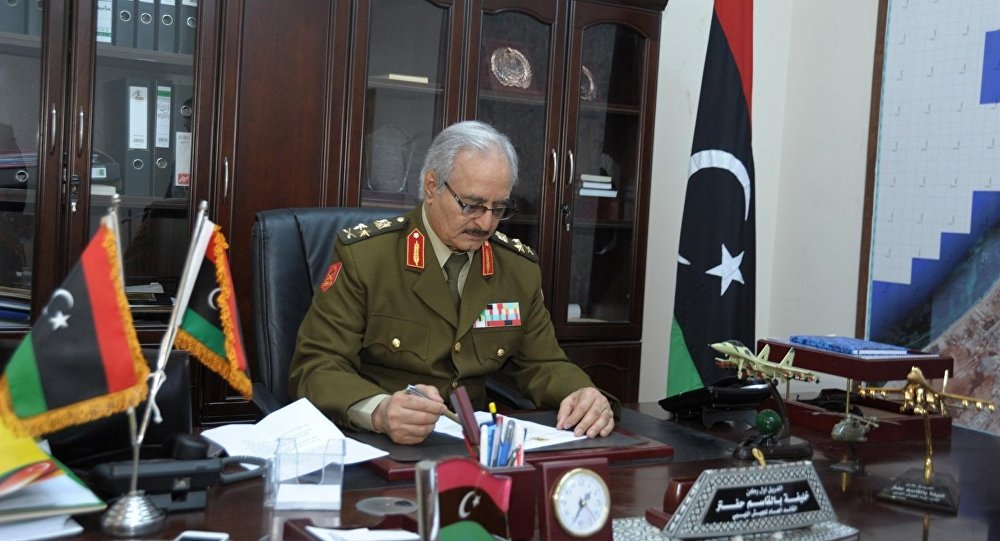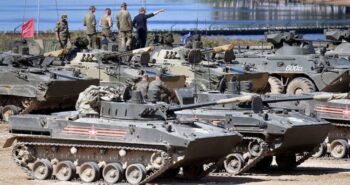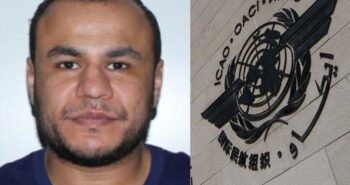By Dr. Theodore Karasik
Libyan Field Marshal Khalifa Haftar’s plans for Libya took an abrupt turn for the worse marking yet again another stage of the Libyan Civil War.
Tripoli-based forces, with international support from Italy, partnered with the Benghazi Defense Brigade (BDB) to sweep into the Sirte Oil Basin. Once again, Libya’s natural wealth became the epicenter for a struggle over power. But the implications for Haftar and his backers are significant.
Two weeks ago, Libya talks in Cairo cemented the beleaguered country’s future. UN-installed Government of National Accord (GNA) Libyan Prime Minister Fayez Serraj, from Tripoli, failed to meet with Haftar.
The meeting was a non-starter for Serraj who bore witness to Egypt’s chief-of-staff, Lt. Gen. Mahmoud Hegazy, trying to get the Libyan Field Marshal to talk with him. Serraj left empty-handed which, according to a Gulf Cooperation Council official, which gave a green light for “on the ground” support for Haftar at his military bases in Libya. These plans didn’t work out.
On March 3, BDB captured the Sirte Basin. This is the third time that the BDB carried out an offensive in the Sirte Basin. BDB attacked Sirte Basin territory to capture oil facilities last July and December 2016. But both offensives failed.
This month BDB succeeded as a result of Haftar losing valuable tribal support, the loss of LNA mercenaries from southern Libya and sub-Saharan Africa that had been bribed by the BDB, and the “weak status” of Haftar’s Petroleum Facilities Guard (PFG) force protection capability due to the transfer of the LNA’s main forces to other locations.
The Sirte Basin
The BDB seizure of the Sirte Basin surprisingly caught Haftar’s forces off guard. BDB entered the Ras Lanuf and Es-Sider facilities, forcing the LNA to retreat. Now, LNA forces are countering with airstrikes and ground action. To be sure, control over the Sirte Oil Basin is again the card in play over Libya’s future.
Haftar’s control of the Sirte Oil Basin after the LNA captured it from then- PFG leader Ibrahim al-Jadhran in August 2016 allowed direct revenue from the terminals under his control to go to the Libyan Central Bank. These money flows boosting the East’s coffers angered Tripoli and hence the offensive by the BDB took place.
Understanding BDB’s objectives is important. The Tripoli-led offensive by the BDB is a project that runs counter to Haftar and his allies’ secular leanings. According to sources, the BDB is based in the west, between Tripoli, Misrata and Jufra, and who are united by their mission to return to Benghazi from where they were thrown out by Haftar last year.
Some BDB are members of Ansar al-Sharia, a hardline group that has been designated as a terrorist organization by the United Nations. It should be noted that a number of al-Qaeda linked social media outlets are praising the BDB offensive, and an al-Qaeda in the Islamic Maghreb (AQIM) Telegram channel has posted videos of the BDB forces inside Sirte Gulf ports.
Political split
Politically, BDB fighters are split between the GNA and its rival government in Tripoli, the General National Congress (GNC), led by Khalifa Ghwell, and his ally the Mufti of Tripoli Sadiq al-Ghariani. Militarily, BDB is supported by GNA’s Minister of Defense, al-Mahdi al-Barghati and BDB receiving equipment from a number of sources.
Thus, Tripoli and the BDB saw an opportunity to usurp physical control of the Sirte Basin away from Haftar. On the political side, although Fayez Serraj’s GNA officially rejected the offensive, the Grand Mufti and probably also Ghwell are in support of it. The operation needs to be seen within the context of Tripoli militias close to Ghwell briefly occupying the National Oil Corporation headquarters in the city just prior to the BDB offensive.
The future of Libya’s oil is also part of Tripoli’s calculus. During the run-up to the opening Tripoli-led BDB offensive, Libyan National Oil Corporation (NOC) Chairman Mustafa Sanallah encouraged investors to come back to Libya to bolster the sector’s recovery.
Despite Sanallah’s neutrality Tripoli thinks Sanallah is pro-HoR because he struck a deal with Haftar’s forces, allowing the LNA to continue holding the oil crescent export terminals. But Sanallah is no more “pro-Haftar” than he was “pro-Zintani” after he negotiated the reopening of the Rayana pipeline connecting El-Feel and Sharara to Mellitah.
The Italian role
The role of Italy in the ongoing Sirte Basin struggle cannot be understated. Given that Rome has staunchly supported the GNA since its December 2015 inception, the Italian government and Haftar are on terrible terms with Libyan officials in Tobruk accusing Libya’s former colonial ruler of picking the wrong side in the North African country’s raging civil war.
A belief held by many in Italy is that while Haftar has a role to play in military operations against extremist forces such as ISIS and other extremists, the “renegade general” is not the solution to Libya’s political crisis.
Rome is not interested in seeing Moscow and Cairo work together to establish a secular authoritarian strongman in Cyrenaica, but has instead lent its support to UN-backed efforts aimed at installing a democratic government in Libya, which includes certain actors deemed “terrorists”.
Haftar’s setbacks might mean that the HoR will come under enough pressure to make further concessions to the GNA, which it currently does not recognize. It will be important to monitor the next moves of those who have been supportive of Haftar, and to what extent they invest and take risks in backing Tobruk.
Not lost in the equation is what these powers have to gain from Libya’s natural resource wealth if Haftar can later usurp control of vital oil facilities in the Sirte Basin.
Will Haftar’s recent losses mark the beginning of his fall in post-Qaddafi Libya or just more ebb and flow in the highly fluid civil war? Regardless of the fate of the “renegade general” who once fought alongside Muammar Qaddafi, his enemies have compromised his position in Libya for now.
***
Dr. Theodore Karasik is a Washington DC-based analyst of regional geo-political affairs. He received his Ph.D in History from UCLA in Los Angeles, California in four fields: Middle East, Russia, Caucasus, and a specialized sub-field in Cultural Anthropology focusing on tribes and clans.
____________




